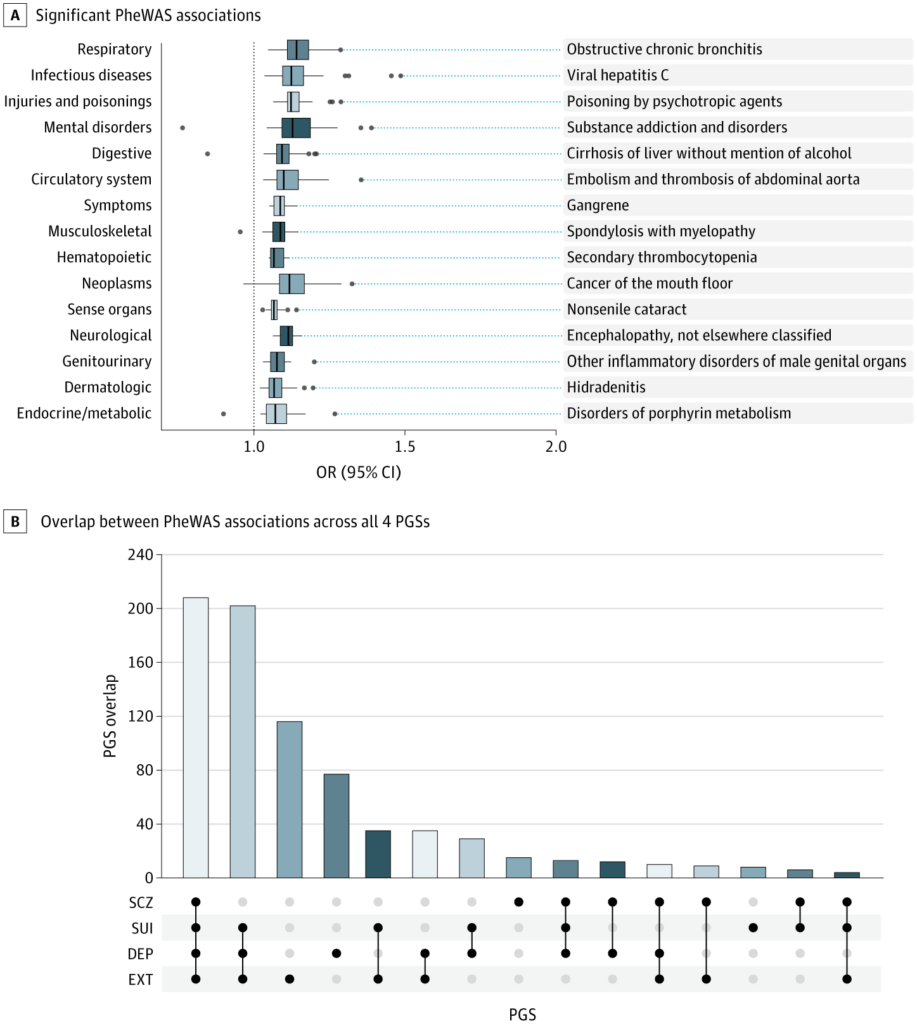Million Veteran Program Used to Determine Genetic Risks

Phenome-Wide Association Study (PheWAS) of Externalizing Polygenic Risk in the Million Veterans Program (MVP)PheWAS associations with externalizing (EXT) disorders polygenic risk scores (PGSs) in veterans of the primarily European ancestries (N = 406, 255). Phecodes are grouped into 17 categories: infectious diseases, neoplasms, endocrine/metabolic, hematopoietic, mental disorders, neurological, sense organs, circulatory system, respiratory, digestive, genitourinary, pregnancy complications, dermatologic, musculoskeletal, congenital anomalies, symptoms, and injuries & poisonings. A, Box plots of effect sizes (odds ratios [ORs]) for the 619 of 1652 significant PheWAS associations below the Bonferroni corrected P value threshold (P < 7.57 × 10−6). B, Upset plot of overlap between phenome-wide significant associations (P < 7.57 × 10−6) across all 4 PGSs (EXT, depression, schizophrenia, and suicide attempt).
A new study in JAMA Psychiatry sought to determine the correlates of risk for disinhibited behaviors in the U.S. veteran population.1
The cohort study led by researchers from the VA New York Harbor Healthcare System and SUNY Downstate Health Sciences University, both in Brooklyn, used electronic health record data from 560,824 veterans to determine that risk for disinhibited behaviors was associated with medical outcomes across all bodily systems, including substance use disorders, suicide and self-harm, liver disease, chronic airway obstruction and viral hepatitis C.
“Many of these associations were significant across ancestry and after accounting for other comorbid problems,” the authors pointed out. “Results suggest that risk for disinhibited behaviors was associated with many health outcomes of particular relevance within the veteran community.”
It was no surprise to researchers that the largest associations across all models were in the phecode domain of mental disorders, especially SUDs (alcohol, tobacco and other substances), although other psychiatric problems, including conduct disorder, personality disorders and attention-deficit/hyperactivity disorder (ADHD) were also associated.
“In terms of SUDs, only tobacco use disorders remained significant after multiple testing correction,” they wrote. “Moreover, many of the associations that replicated within a family were likely consequences of SUDs. These included chronic airway obstruction (smoking related), chronic liver disease, cirrhosis (alcohol related), and viral hepatitis C (intravenous drug use related). The within-family associations point to the potential causal impact of risk for externalizing on these medical conditions, likely mediated through SUDs. However, within-family associations can be biased in the presence of genetic nurture and sibling effects.”
With information from the VHA’s Million Veteran Program (MVP), a series of phenome-wide association studies (PheWASs) of polygenic risk scores (PGSs) for EXT disorders was conducted using electronic health records. The researchers first conducted ancestry-specific PheWASs of EXT PGSs in the African, European and Hispanic or Latin American ancestries. Next, they performed a conditional PheWAS, covarying for PGSs of comorbid psychiatric problems (depression, schizophrenia and suicide attempt; European ancestries only). Finally, to adjust for unmeasured confounders, a within-family analysis of significant associations from the main PheWAS was performed in full siblings (European ancestries only).
Analyses of the study, which included the electronic health record data from VA healthcare centers enrolled in MVP, took place from February 2022 to August 2023 covering a period from October 1999 to January 2020.
The VHA patients included in the study had a mean age of 67.9, and 91.4% were male. Results indicated that the EXT PGS was associated with 619 outcomes, of which 188 were independent of risk for comorbid problems or PGSs. Those included: odds ratio [OR], 1.02; 95% CI, 1.01-1.03 for overweight/obesity to OR, 1.44; 95% CI, 1.42-1.47 for viral hepatitis C.
“Of the significant outcomes, 73 (11.9%) were significant in the African results and 26 (4.5%) were significant in the Hispanic or Latin American results,” the researchers advised. “Within-family analyses uncovered robust associations between EXT PGS and consequences of SUDs, including liver disease, chronic airway obstruction, and viral hepatitis C.”
Negative Consequences
The study concluded that the results suggest a shared polygenic basis of EXT disorders, independent of risk for other psychiatric problems. “In addition, this study found associations between EXT PGS and diagnoses related to SUDs and their sequelae,” the authors wrote. “Overall, this study highlighted the potential negative consequences of EXT disorders for health and functioning in the U.S. veteran population.”
Background information in the article noted that psychiatric disorders “have far-reaching consequences for affected individuals, their families, communities, and the broader society. Many diagnoses are strongly comorbid and share, at least in part, a common etiology. Disorders related to behavioral disinhibition, such as substance use disorders (SUDs) and antisocial personality disorder, have been labeled as externalizing (EXT) disorders. Twin and family studies suggest that the common liability toward EXT is highly heritable (approximately 80%).”
Shared genome facts for EXT have been found with risky sexual behaviors, personality characteristics and neurodevelopmental disorders, the authors add, explaining, “importantly, genetic liability for EXT overlaps with other phenotypes of public health relevance, such as other psychiatric problems, suicidal thoughts and behaviors, other SUDs and a range of other medical conditions (e.g., ischemic heart disease, liver disease, viral hepatitis). The widespread impact of risk for EXT makes it a potential target for early intervention and prevention.”
The researchers emphasized that “intervention and prevention efforts that identify ways to target and monitor the behavioral manifestations of externalizing risk could substantially improve morbidity and mortality outcomes.”
- Barr PB, Bigdeli TB, Meyers JL, et al. Correlates of Risk for Disinhibited Behaviors in the Million Veteran Program Cohort. JAMA Psychiatry. Published online November 08, 2023. doi:10.1001/jamapsychiatry.2023.4141

